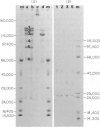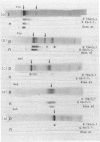Abstract
Eight human IgA1 myeloma proteins were analysed by SDS-PAGE. These experiments showed that purified IgA1 proteins comprise both fully S-S bonded and partly S-S bonded molecules. Pepsin digestion of the IgA1 proteins yielded three four-chain and two two-chain fragments. The four-chain fragments are likely to be derived from intact IgA through cleavage of its alpha chains at different sites: between the CH2 and CH3 domains or in the hinge region. The occurrence of F(abc) (ab') fragments, with alpha chains of different lengths, showed that the alpha chains of IgA can be cleaved independently at the hinge region site. The two-chain pepsin fragments must originate from IgA molecules, which lack inter-assay-chain disulphide linkages. The fragments F(abc)2 and Fabc tended to form dimers, probably through non-covalent interactions of their CH2 domains. An immunoblotting method was used to identify Fd-, CH2- and CH3-specific anti-IgA antibodies. The CH2-specific antibodies could be subdivided into antibodies recognizing an isotype present on both four-chain and two-chain molecules or on two-chain molecules only.
Full text
PDF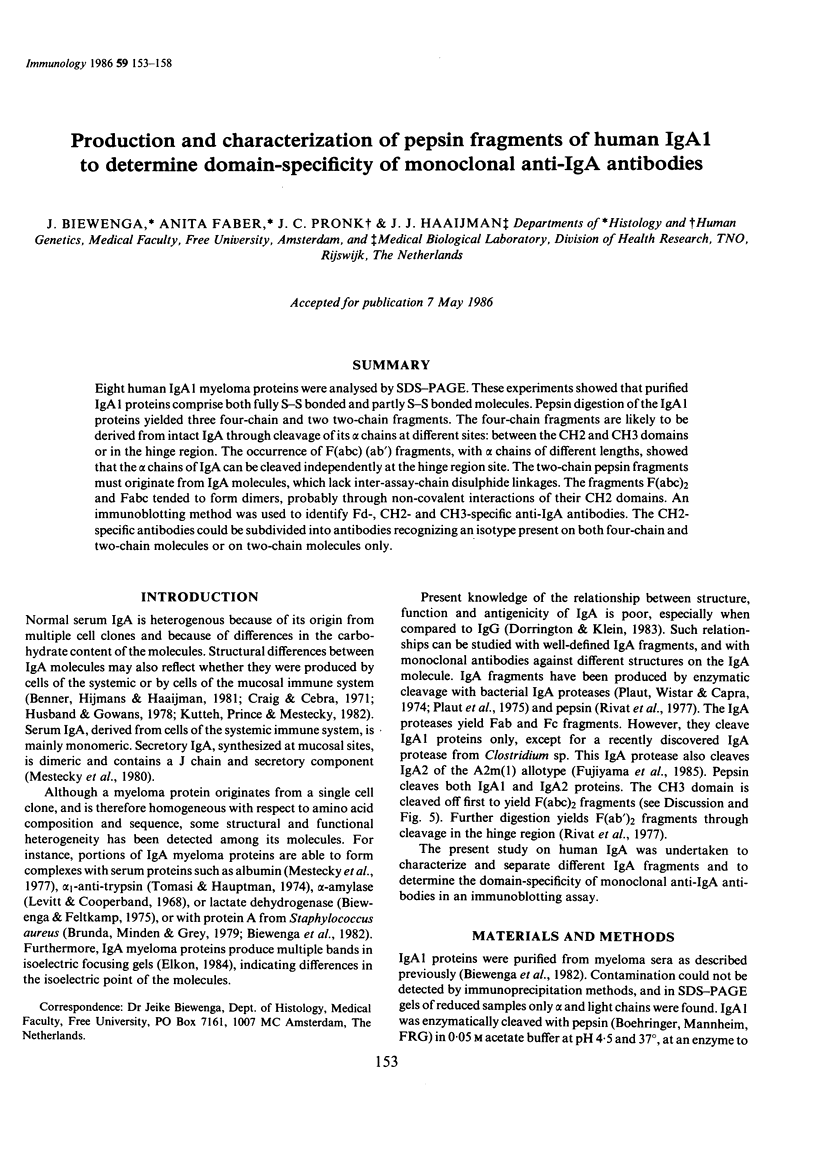
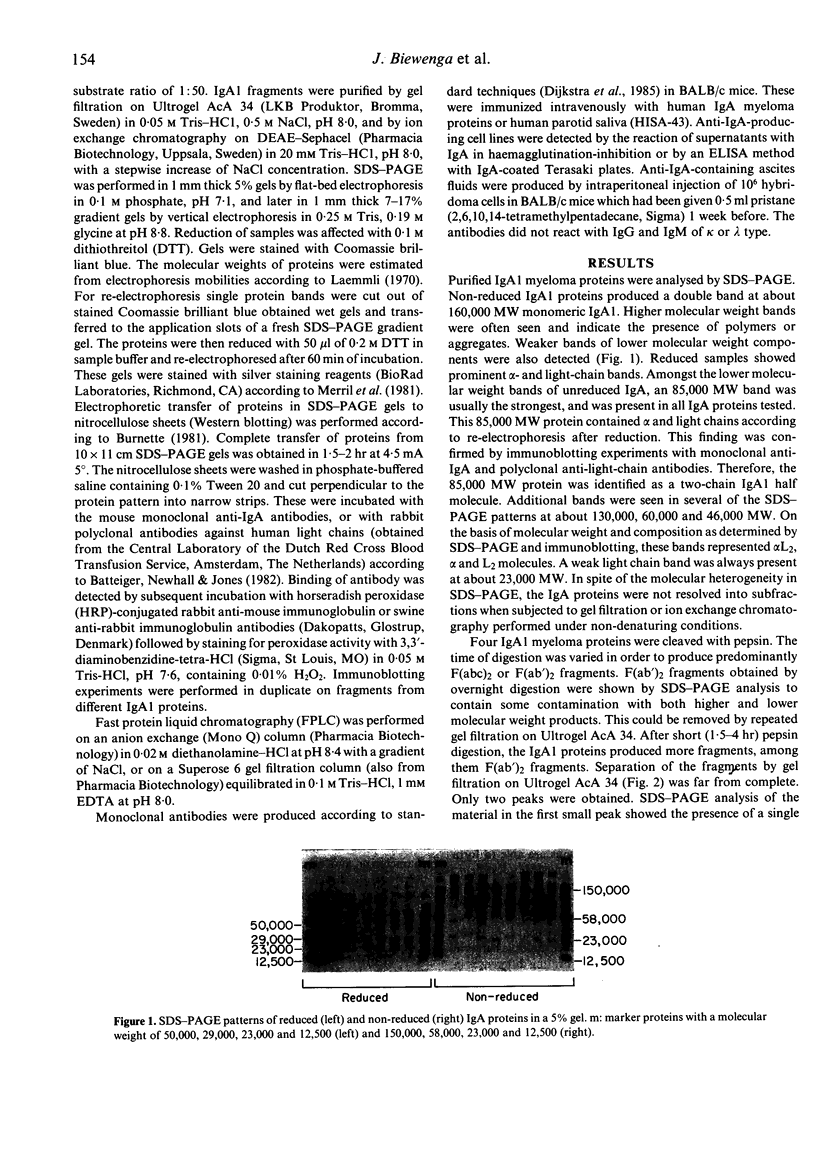
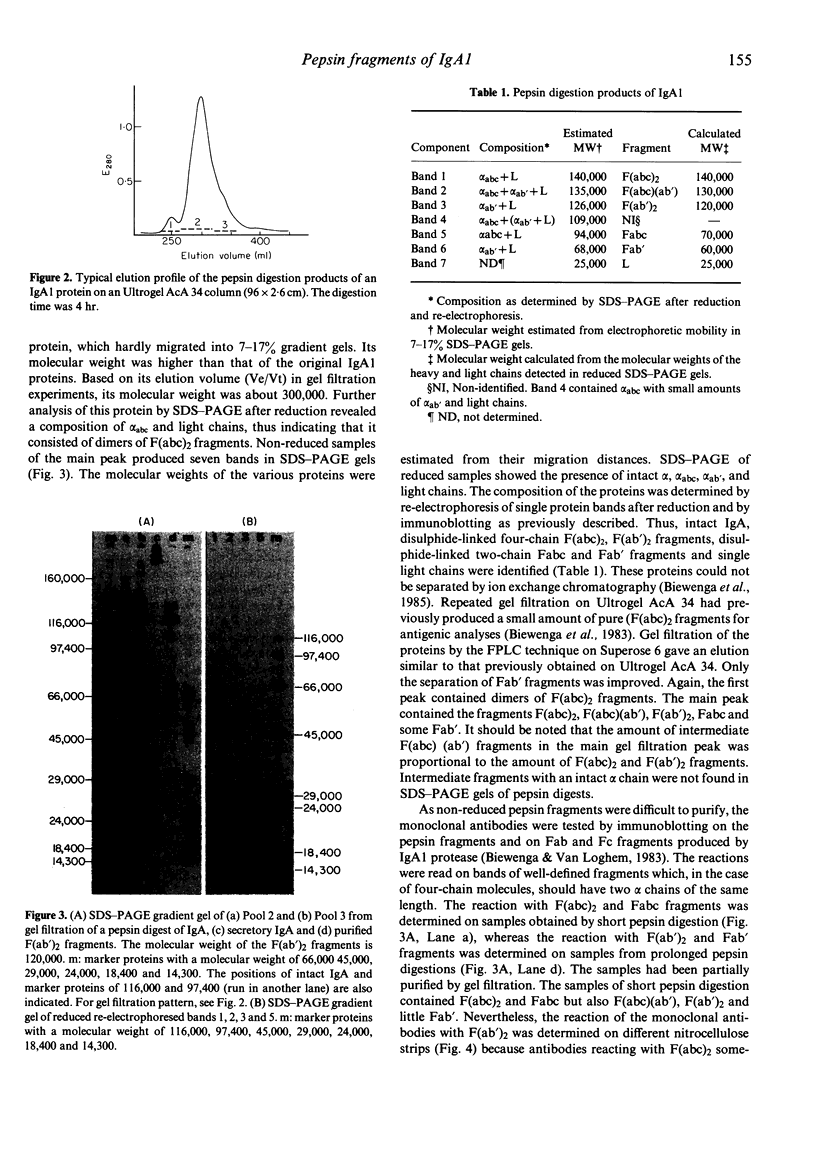
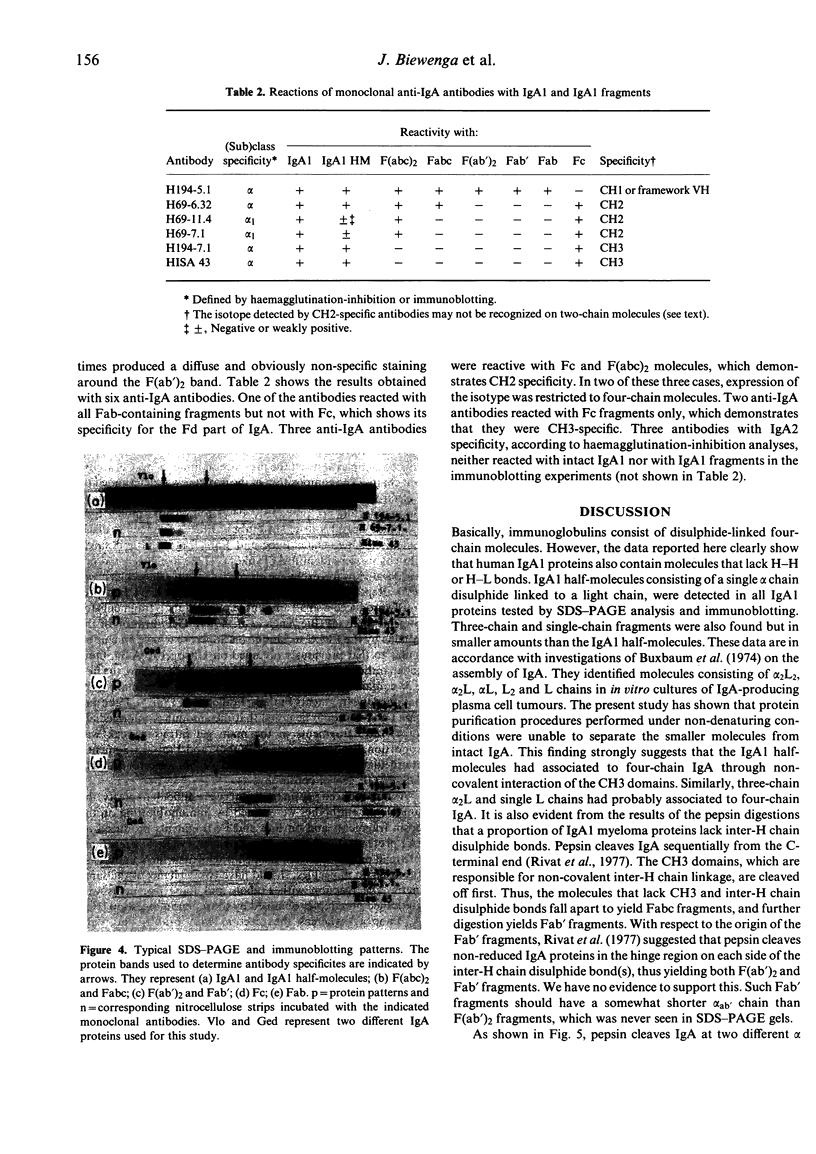
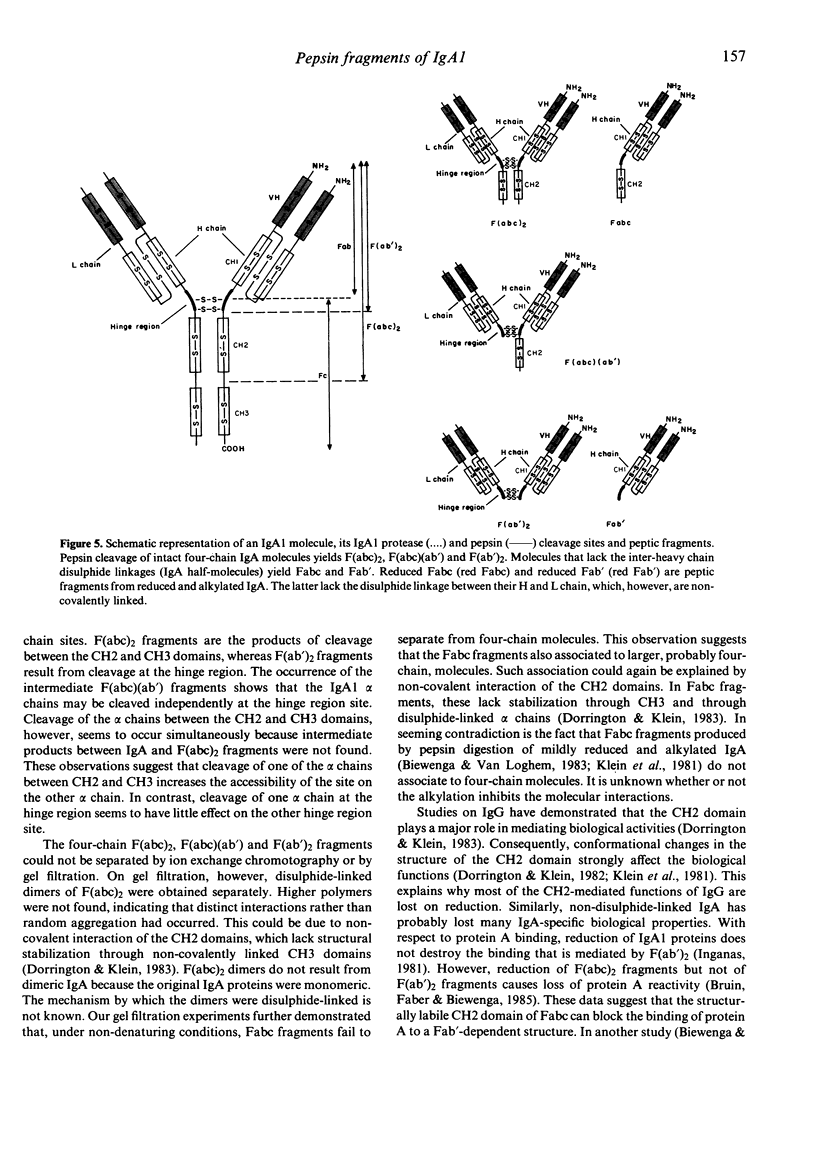
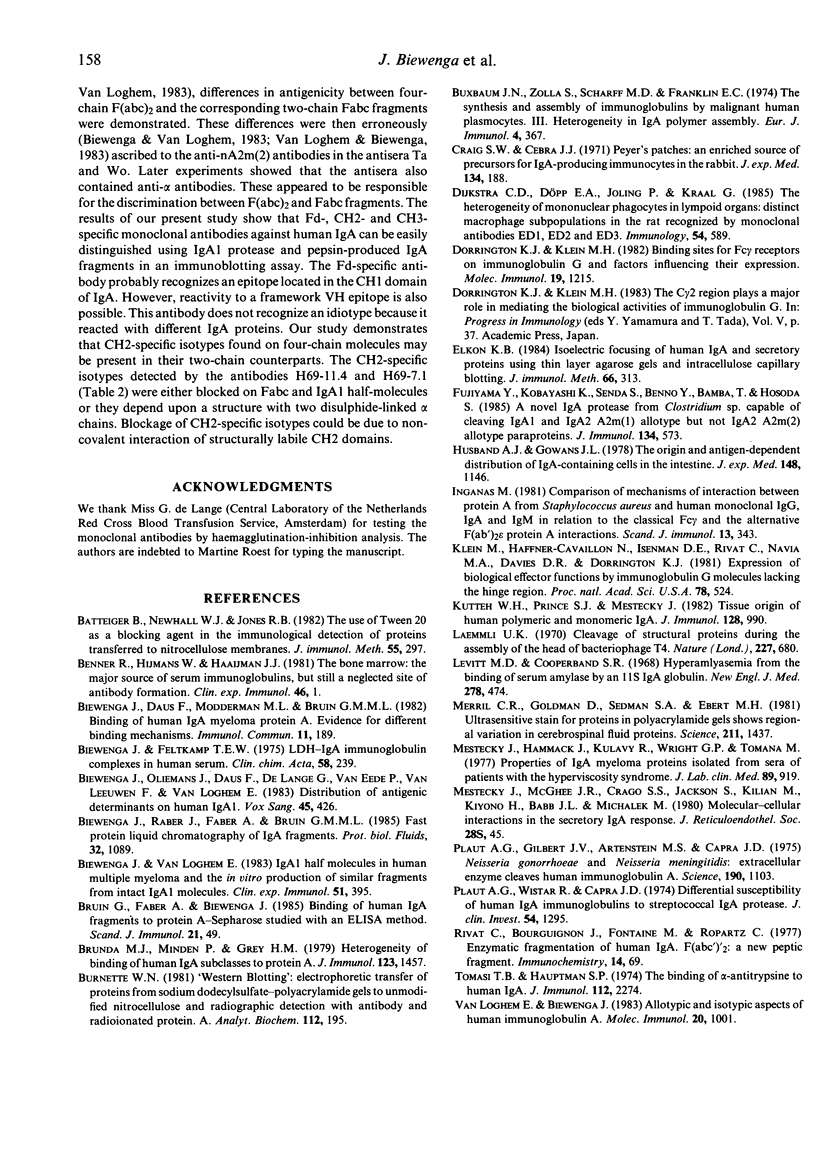
Images in this article
Selected References
These references are in PubMed. This may not be the complete list of references from this article.
- Batteiger B., Newhall W. J., 5th, Jones R. B. The use of Tween 20 as a blocking agent in the immunological detection of proteins transferred to nitrocellulose membranes. J Immunol Methods. 1982 Dec 30;55(3):297–307. doi: 10.1016/0022-1759(82)90089-8. [DOI] [PubMed] [Google Scholar]
- Benner R., Hijmans W., Haaijman J. J. The bone marrow: the major source of serum immunoglobulins, but still a neglected site of antibody formation. Clin Exp Immunol. 1981 Oct;46(1):1–8. [PMC free article] [PubMed] [Google Scholar]
- Biewenga J., Daus F., Modderman M. L., Bruin G. M. Binding of human IgA myeloma proteins to protein A. Evidence for different binding mechanisms. Immunol Commun. 1982;11(3):189–200. doi: 10.3109/08820138209094130. [DOI] [PubMed] [Google Scholar]
- Biewenga J., Feltkamp T. E. LDH-IgA immunoglobulin complexes in human serum. Clin Chim Acta. 1975 Feb 8;58(3):239–249. doi: 10.1016/0009-8981(75)90443-x. [DOI] [PubMed] [Google Scholar]
- Biewenga J., Oliemans J., Daus F., de Lange G., van Eede P., van Leeuwen F., van Loghem E. Distribution of antigenic determinants on human IgA1. Vox Sang. 1983;45(6):426–431. doi: 10.1111/j.1423-0410.1983.tb01939.x. [DOI] [PubMed] [Google Scholar]
- Biewenga J., Van Loghem E. IgA1 half molecules in human multiple myeloma and the in vitro production of similar fragments from intact IgA1 molecules. Clin Exp Immunol. 1983 Feb;51(2):395–400. [PMC free article] [PubMed] [Google Scholar]
- Bruin G., Faber A., Biewenga J. Binding of human IgA fragments to protein A-Sepharose studied with an ELISA method. Scand J Immunol. 1985 Jan;21(1):49–54. doi: 10.1111/j.1365-3083.1985.tb01402.x. [DOI] [PubMed] [Google Scholar]
- Brunda M. J., Minden P., Grey H. M. Heterogeneity of binding of human IgA subclasses to protein A. J Immunol. 1979 Oct;123(4):1457–1461. [PubMed] [Google Scholar]
- Burnette W. N. "Western blotting": electrophoretic transfer of proteins from sodium dodecyl sulfate--polyacrylamide gels to unmodified nitrocellulose and radiographic detection with antibody and radioiodinated protein A. Anal Biochem. 1981 Apr;112(2):195–203. doi: 10.1016/0003-2697(81)90281-5. [DOI] [PubMed] [Google Scholar]
- Buxbaum J. N., Zolla S., Scharff M. D., Franklin E. C. The synthesis and assembly of immunoglobulins by malignant human plasmacytes. 3. Heterogeneity in IgA polymer assembly. Eur J Immunol. 1974 May;4(5):367–369. doi: 10.1002/eji.1830040512. [DOI] [PubMed] [Google Scholar]
- Craig S. W., Cebra J. J. Peyer's patches: an enriched source of precursors for IgA-producing immunocytes in the rabbit. J Exp Med. 1971 Jul 1;134(1):188–200. doi: 10.1084/jem.134.1.188. [DOI] [PMC free article] [PubMed] [Google Scholar]
- Dijkstra C. D., Döpp E. A., Joling P., Kraal G. The heterogeneity of mononuclear phagocytes in lymphoid organs: distinct macrophage subpopulations in the rat recognized by monoclonal antibodies ED1, ED2 and ED3. Immunology. 1985 Mar;54(3):589–599. [PMC free article] [PubMed] [Google Scholar]
- Dorrington K. J., Klein M. H. Binding sites for Fc gamma receptors on immunoglobulin G and factors influencing their expression. Mol Immunol. 1982 Oct;19(10):1215–1221. doi: 10.1016/0161-5890(82)90286-3. [DOI] [PubMed] [Google Scholar]
- Elkon K. B. Isoelectric focusing of human IgA and secretory proteins using thin layer agarose gels and nitrocellulose capillary blotting. J Immunol Methods. 1984 Feb 10;66(2):313–321. doi: 10.1016/0022-1759(84)90343-0. [DOI] [PubMed] [Google Scholar]
- Fujiyama Y., Kobayashi K., Senda S., Benno Y., Bamba T., Hosoda S. A novel IgA protease from Clostridium sp. capable of cleaving IgA1 and IgA2 A2m(1) but not IgA2 A2m(2) allotype paraproteins. J Immunol. 1985 Jan;134(1):573–576. [PubMed] [Google Scholar]
- Husband A. J., Gowans J. L. The origin and antigen-dependent distribution of IgA-containing cells in the intestine. J Exp Med. 1978 Nov 1;148(5):1146–1160. doi: 10.1084/jem.148.5.1146. [DOI] [PMC free article] [PubMed] [Google Scholar]
- Inganäs M. Comparison of mechanisms of interaction between protein A from Staphylococcus aureus and human monoclonal IgG, IgA and IgM in relation to the classical FC gamma and the alternative F(ab')2 epsilon protein A interactions. Scand J Immunol. 1981;13(4):343–352. doi: 10.1111/j.1365-3083.1981.tb00143.x. [DOI] [PubMed] [Google Scholar]
- Klein M., Haeffner-Cavaillon N., Isenman D. E., Rivat C., Navia M. A., Davies D. R., Dorrington K. J. Expression of biological effector functions by immunoglobulin G molecules lacking the hinge region. Proc Natl Acad Sci U S A. 1981 Jan;78(1):524–528. doi: 10.1073/pnas.78.1.524. [DOI] [PMC free article] [PubMed] [Google Scholar]
- Kutteh W. H., Prince S. J., Mestecky J. Tissue origins of human polymeric and monomeric IgA. J Immunol. 1982 Feb;128(2):990–995. [PubMed] [Google Scholar]
- Laemmli U. K. Cleavage of structural proteins during the assembly of the head of bacteriophage T4. Nature. 1970 Aug 15;227(5259):680–685. doi: 10.1038/227680a0. [DOI] [PubMed] [Google Scholar]
- Levitt M. D., Cooperband S. R. Hyperamylasemia from the binding of serum amylase by an 11S IgA globulin. N Engl J Med. 1968 Feb 29;278(9):474–479. doi: 10.1056/NEJM196802292780903. [DOI] [PubMed] [Google Scholar]
- Merril C. R., Goldman D., Sedman S. A., Ebert M. H. Ultrasensitive stain for proteins in polyacrylamide gels shows regional variation in cerebrospinal fluid proteins. Science. 1981 Mar 27;211(4489):1437–1438. doi: 10.1126/science.6162199. [DOI] [PubMed] [Google Scholar]
- Mestecky J., Hammack W. J., Kulhavy R., Wright G. P., Tomana M. Properties of IgA myeloma proteins isolated rom sera of patients with the hyperviscosity syndrome. J Lab Clin Med. 1977 May;89(5):919–927. [PubMed] [Google Scholar]
- Plaut A. G., Gilbert J. V., Artenstein M. S., Capra J. D. Neisseria gonorrhoeae and neisseria meningitidis: extracellular enzyme cleaves human immunoglobulin A. Science. 1975 Dec 12;190(4219):1103–1105. doi: 10.1126/science.810892. [DOI] [PubMed] [Google Scholar]
- Plaut A. G., Wistar R., Jr, Capra J. D. Differential susceptibility of human IgA immunoglobulins to streptococcal IgA protease. J Clin Invest. 1974 Dec;54(6):1295–1300. doi: 10.1172/JCI107875. [DOI] [PMC free article] [PubMed] [Google Scholar]
- Tomasi T. B., Jr, Hauptman S. P. The binding of alpha-1 antitrypsin to human IgA. J Immunol. 1974 Jun;112(6):2274–2277. [PubMed] [Google Scholar]
- van Loghem E., Biewenga J. Allotypic and isotypic aspects of human immunoglobulin A. Mol Immunol. 1983 Sep;20(9):1001–1007. doi: 10.1016/0161-5890(83)90041-x. [DOI] [PubMed] [Google Scholar]




